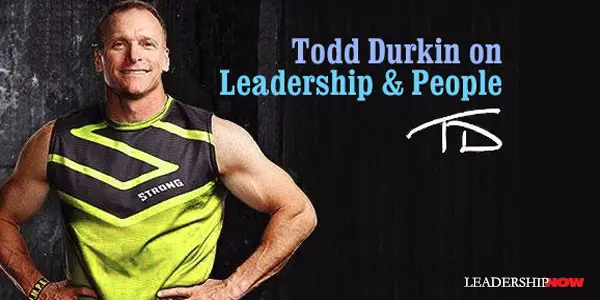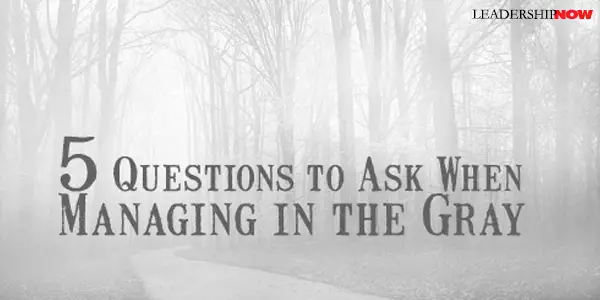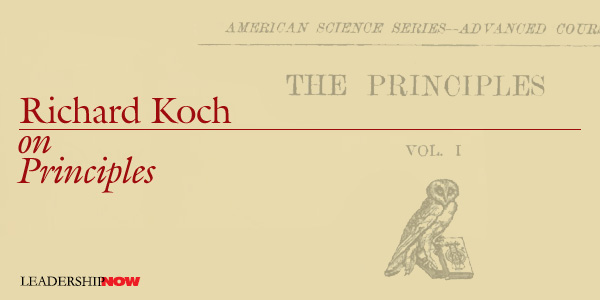 Leading Blog | Posts by Month |
 Leading Blog | Posts by Month |
10.31.16

LeadershipNow 140: October 2016 Compilation
See more on
Posted by Michael McKinney at 02:58 PM
10.10.16

Todd Durkin on Leadership & People
TODD DURKIN is one of America's top fitness trainers helping people move beyond their perceived limits from the inside out. The principles he uses in his approach to his work are something all leaders can consider and apply. Durkin brings servant leadership to all that he does. He has been motivating others with his Word of the Week (WOW) since 2011 and has now compiled them in a single book, The WOW Book. His WOW chapter titled Leadership and People is on–target. He writes: I love studying great coaches. In any sport. And on all levels. One of those coaches is Dick Vermeil. Coach Vermeil coached three different NFL teams. The Philadelphia Eagles. The St. Louis Rams. And the Kansas City Chiefs. In 1999, he led the Rams to a Super Bowl championship. He amassed 126 wins in his 29-year NFL head-coaching career. And he was a three-time NFL Coach of the Year. He has positively impacted thousands of men in his coaching tenure. On this one particular evening in 2013, I had the opportunity to hear him speak to a few hundred fitness trainers/pros at a Perform Better conference in Providence, Rhode Island. And he was awesome! Coach Vermeil revealed his “Seven Common Sense Coaching Points” that make the foundation for any team, business, company, or family. In all seven points, there was ONE commonality: PEOPLE. Without great PEOPLE, there are no great businesses, no great TEAMS, no great organizations, no great families, no great companies, and no great brands. Coach Vermeil talked about how the most important resource of any company is its PEOPLE: their personal dignity, pride in what they do, and the trust that they have in management. At the end of every business/calendar year an important and first question a LEADER should ask is: Do we have better people in our company? Do we have better people on December 31st (the year’s end), than we did on January first (the year’s beginning)? Are we better TODAY than we were at the start of the year? Think about what Ford says in its MISSION statement: “Our PEOPLE are the source of our strength.” Think about what Hilton Hotels says in its VALUES statement: “PEOPLE are our most important asset.” YOU are a LEADER of your business, your TEAM, your family, your organization . . . regardless of your title! Your PEOPLE need to know what to expect.

Posted by Michael McKinney at 08:26 PM
10.06.16

The Five Friends Business Summit
You probably have seen the 5 Friends Insights on Business and Life videos. Now they bring you the Five Friends Business Summit on November 2-3, 2016 in Las Vegas, Nevada. At this business summit you will receive the same high-level, intensive content usually reserved to the Fortune 500 clients of the Five Friends. 
The Five best-selling authors, Speaker Hall of Fame recipients, internationally-acclaimed business consultants and best buddies are: Together they will cover:
UPDATE 2019: This event is now called the Ultimate Business Summit.
Posted by Michael McKinney at 02:57 PM
10.05.16

5 Questions to Ask When Managing in the Gray
JOSEPH BADARACCO PROVIDES A WAY to resolve the inevitable gray areas we will all face from time to time in Managing in the Gray. It is the core of a leaders work. Gray areas demand our best judgment. The five questions provide a way to get there. They are “a distinctive way of sizing up gray area issues, analyzing them carefully, grappling with their full, human complexity, and then—and only then—making final decisions.” Avoid the temptation to skip a question or pick a favorite. “This approach improves deliberation and judgment because the questions complement, correct, and strengthen each other.” 5 Questions to work through the gray of difficult decisions: What are the net, net consequences? The critical first step requires thinking deeply putting aside your own self-interest. Don’t oversimplify. That means don’t just think about those things you can put a number to. “Life is a rich canvas, not a cartoon.” Understanding the net, net consequences means thinking in terms of “everything that matters to us as human beings: hope, joy, security, freedom from hazards, health, friendship, and love, risk, suffering, and dreams.” What are we trying to do for people, not to them? Keep in mind we have a strong self-enhancement bias. We tend to see too quickly. The process is important when working on gray area problems. “How you work on a problem can be as important as what you ultimately decide to do.” Get the right people in the room. Assign a couple of people to play devil’s advocate. Begin by developing a list of things you could do as opposed to what you should do. Then work out the possible outcomes of each possibility. What are my core obligations? “When trying to resolve a gray area problem, you have to develop an answer—for yourself—to the question of what your core human obligations require you to do and not do in the situation you face.” In a business situation, it is important to take a hard look at the economics but at the same time, you need to look past the economics and try resolving the issue like a human being. When looking at a gray area problem you must awaken your moral imagination. Edmund Burke described it as a “reaction to a situation that the heart owns and the understanding ratifies.” Again, make it part of the process. What will work in the world as it is? More than what will work. What will work in the world as it is? Don’t let idealistic notions distort your thinking. “If you have serious responsibilities, you must avoid the trap of seeing the world as you want it to be.” “The question asks managers if they are prepared to do what is necessary in this world—to serve the interests of people who depend on them and also protect themselves and advance their own objectives.” The question becomes, “How resilient is my plan and how resilient am I?” Badaracco offers five steps to help you answer with eyes-wide-open realism. Who are we? This questions guides leaders to see their identities as woven into the fabric of their surrounding communities. “It then encourages them to seek options that will reflect, express, and give reality to the norms and values of the communities to which they belong.” We are social creatures. “It is relationships, values, and norms that make us who we are.” See the problem in context. “When you face a hard gray area issue, you should spend a few minutes stepping back and trying to understand the situation in terms of some of the defining experiences in your organization’s history that matter to you and help you understand what your organization stands for.” What can I live with? Not what is best or right, but what you can live with. After all is said and done It is quite possible—even probable—that you will not find a solution. If that’s the case you have to create an answer you can live with. It means “you did all you could, but you’ve only met a minimum standard of acceptability.” And of course, you have to take responsibility for it. “Gray area decisions inevitably reflect and reveal the personal priorities of the person who makes them.” And so these kinds of tough questions push you to reflect on what you can live with. They test competence and character. What are your convictions? Alfred P. Sloan wrote in his autobiography, “The final act of business judgment is, of course, intuitive.” Badaracco concludes: “Men and women should approach gray area issues as managers and resolve them as human beings.” 
Posted by Michael McKinney at 04:09 PM
10.03.16

Richard Koch on Principles
PRINCIPLES ARE WONDERFUL THINGS, because if they are really powerful they can save us enormous effort and stop us going down dead ends. In science and business there are just a few such principles; but whereas most scientists are aware of the beautiful principles in their field, few business people are guided by principles in their daily work, preferring to rely on methods—the next level down. Yet as the nineteenth-century philosopher Ralph Waldo Emerson said, “As to methods there may be a million and then some, but principles are few. The man who grasps principles can successfully select his own methods. The man who tries methods, ignoring principles, is sure to have trouble.” To qualify, a principle must be so overwhelmingly powerful that ordinary mortals—such as you or me—can reliable create ordinary results, not through personal brilliance, but just by following the principle carefully and with a modicum of common sense. Adapted from Simplify: How the Best Businesses in the World Succeed by Richard Koch and Greg Lockwood. 
Posted by Michael McKinney at 08:19 PM
10.01.16

First Look: Leadership Books for October 2016Here's a look at some of the best leadership books to be released in October.    
For bulk orders call 1-800-423-8273  Build your leadership library with these specials on over 100 titles. All titles are at least 40% off the list price and are available only in limited quantities. "A room without books is like a body without a soul." — Marcus Tullius Cicero
Posted by Michael McKinney at 08:31 AM
|
BUILD YOUR KNOWLEDGE


How to Do Your Start-Up Right STRAIGHT TALK FOR START-UPS 
Grow Your Leadership Skills NEW AND UPCOMING LEADERSHIP BOOKS 
Leadership Minute BITE-SIZE CONCEPTS YOU CAN CHEW ON 
Classic Leadership Books BOOKS TO READ BEFORE YOU LEAD |
|